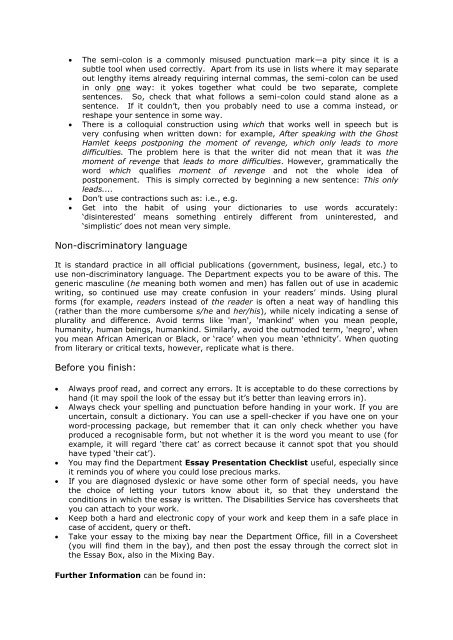STYLE SHEET
STYLE SHEET
STYLE SHEET
Create successful ePaper yourself
Turn your PDF publications into a flip-book with our unique Google optimized e-Paper software.
� The semi-colon is a commonly misused punctuation mark—a pity since it is a<br />
subtle tool when used correctly. Apart from its use in lists where it may separate<br />
out lengthy items already requiring internal commas, the semi-colon can be used<br />
in only one way: it yokes together what could be two separate, complete<br />
sentences. So, check that what follows a semi-colon could stand alone as a<br />
sentence. If it couldn‘t, then you probably need to use a comma instead, or<br />
reshape your sentence in some way.<br />
� There is a colloquial construction using which that works well in speech but is<br />
very confusing when written down: for example, After speaking with the Ghost<br />
Hamlet keeps postponing the moment of revenge, which only leads to more<br />
difficulties. The problem here is that the writer did not mean that it was the<br />
moment of revenge that leads to more difficulties. However, grammatically the<br />
word which qualifies moment of revenge and not the whole idea of<br />
postponement. This is simply corrected by beginning a new sentence: This only<br />
leads....<br />
� Don‘t use contractions such as: i.e., e.g.<br />
� Get into the habit of using your dictionaries to use words accurately:<br />
‗disinterested‘ means something entirely different from uninterested, and<br />
‗simplistic‘ does not mean very simple.<br />
Non-discriminatory language<br />
It is standard practice in all official publications (government, business, legal, etc.) to<br />
use non-discriminatory language. The Department expects you to be aware of this. The<br />
generic masculine (he meaning both women and men) has fallen out of use in academic<br />
writing, so continued use may create confusion in your readers‘ minds. Using plural<br />
forms (for example, readers instead of the reader is often a neat way of handling this<br />
(rather than the more cumbersome s/he and her/his), while nicely indicating a sense of<br />
plurality and difference. Avoid terms like 'man', 'mankind' when you mean people,<br />
humanity, human beings, humankind. Similarly, avoid the outmoded term, 'negro', when<br />
you mean African American or Black, or ‗race‘ when you mean ‗ethnicity‘. When quoting<br />
from literary or critical texts, however, replicate what is there.<br />
Before you finish:<br />
� Always proof read, and correct any errors. It is acceptable to do these corrections by<br />
hand (it may spoil the look of the essay but it‘s better than leaving errors in).<br />
� Always check your spelling and punctuation before handing in your work. If you are<br />
uncertain, consult a dictionary. You can use a spell-checker if you have one on your<br />
word-processing package, but remember that it can only check whether you have<br />
produced a recognisable form, but not whether it is the word you meant to use (for<br />
example, it will regard ‗there cat‘ as correct because it cannot spot that you should<br />
have typed ‗their cat‘).<br />
� You may find the Department Essay Presentation Checklist useful, especially since<br />
it reminds you of where you could lose precious marks.<br />
� If you are diagnosed dyslexic or have some other form of special needs, you have<br />
the choice of letting your tutors know about it, so that they understand the<br />
conditions in which the essay is written. The Disabilities Service has coversheets that<br />
you can attach to your work.<br />
� Keep both a hard and electronic copy of your work and keep them in a safe place in<br />
case of accident, query or theft.<br />
� Take your essay to the mixing bay near the Department Office, fill in a Coversheet<br />
(you will find them in the bay), and then post the essay through the correct slot in<br />
the Essay Box, also in the Mixing Bay.<br />
Further Information can be found in:

















